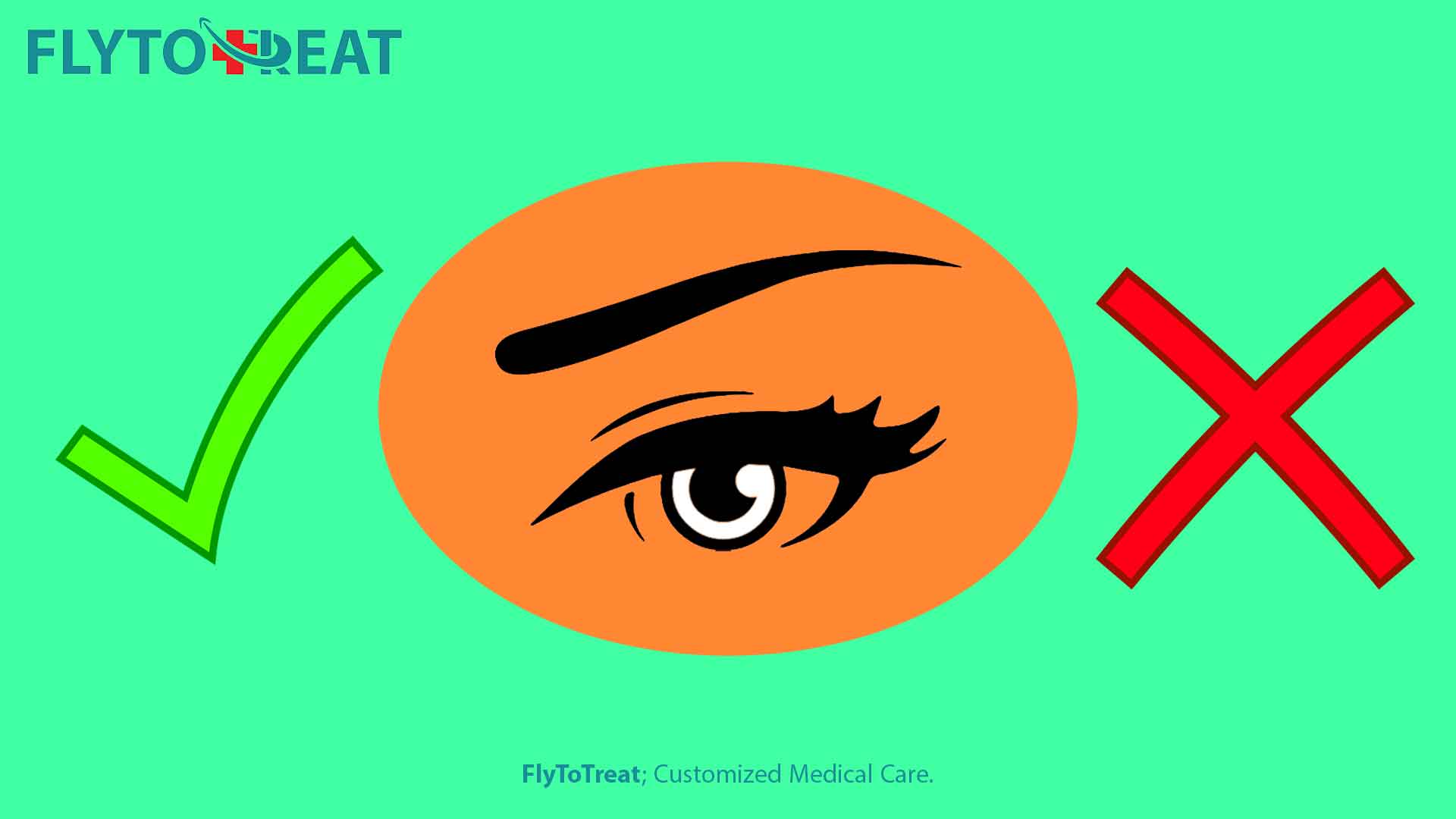
Eyebrow Transplant vs. Microblading
As we age, our eyebrows get thinner, making us look older than we are. We can seem younger, fresher, and more luminous with fuller eyebrows. Nonetheless, there is a growing demand for more long-term solutions. Microblading and eyebrow transplant are two treatments that are now accessible And in this article, we have compared eyebrow implantation vs. microblading.
Your eyebrows may express both your overall look and your sentiments to others. However, not everyone is born with perfectly arched brows. Eyebrow shedding or other difficulties can be caused by various factors, including genetics, accidents, and illnesses.
In this regard, both men and women constantly seek a solution to make their brows more attractive to improve their facial appearance. Women have always used cosmetics to make their eyebrows appear fuller.
At FlytoTreat, we offer a variety of eyebrow enhancements, including microblading, eyebrow tattoos, and eyebrow transplants.
In this essay, we look at the differences between microblading and eyebrow transplantation, as well as their benefits and drawbacks. Continue reading!
Everything About Microblading
Microblading, commonly referred to as "feather touch" or "micro-stroking," is a new manual cosmetic process that has supplanted tattooing and micropigmentation.
Color pigments are implanted into the brow surface using a piece of hand-held equipment with needles. The effect will be very natural if the dyes employed in the method are compatible with the eyebrow hair color.
Although a light local anesthetic is used, this is not a medical operation and is often performed in a cosmetic salon. Clients may notice some swelling and redness in the initial week, but the effects are immediate.
Microblading takes less time and money than an eyebrow transplant, but it's also less permanent and realistic. You'll need to have more microblading operations every 1 to 3 years to keep your brows looking fresh. This is a less expensive but less long-term solution.
Microblading is a delicate treatment that should only be performed by a trained professional. It is carried out at the cosmetic facilities at FlytoTreat by qualified and skilled technicians.
On the other hand, some unlicensed technicians may perform this treatment in their work centers. As a result, you should conduct a thorough investigation before taking action.

Microblading's Benefits
- Your eyebrows will always be flawless:
You won't worry about your brow pomade wiping off at the beach or after a challenging workout. They're fully waterproof, except for the first ten days, when you should avoid getting them wet.
Also, if you're a victim of the 1990s brow tweezing craze, the correct microblading artist will be able to restore your natural brow contour, which is well worth the investment.
-
They have a long lifespan:
It would help if you planned to return to the clinic for a touch-up eight weeks after your first microblading treatment. You may anticipate having your stunning new brows for up to two years once you've finished that.
-
You'll spend less time getting ready in the morning.
You can cut some time off of your daily ritual because your brows will already be flawlessly groomed, allowing you to spend more time with your cup of coffee.
You might even get a few additional minutes of sleep, and who couldn't use a little more of that? The first time spent in the studio is about 2 hours, but consider how much time you'll save over two years!
-
It will help you save money:
You better know how much the price of powders, brow pencils, and pomades constantly mounts up. While the initial cost of microblading may seem frightening, it's still a good investment because it may last up to two years.
Finally, there is a chance to save money by not having to go to Sephora!
Microblading's Drawbacks
- It is not permanent and requires "touch-ups" every eight to thirty months, depending on the skin type and pigment quality.
- Despite the use of a topical anesthetic, the treatment is not painless.
- Following the treatment, you will have minor wounds on your brow that are susceptible to infection and must be properly cared for.
- When done by a non-professional technician, the outcome is unsatisfactory since the look is dependent on the technician's drawing ability.
Recovery Following Microblading
A person's brows may seem darker following the microblading process and for at least one week afterward. Scabbing and mending may also make them feel sharper. It's also common to have some redness and slight swelling.
We will provide aftercare recommendations to our customers, which include:
-
Using antibacterial soap and water, gently wash over the brows with a fingertip for about 10 seconds, rinse, and pat dry.
-
Apply a small quantity of moisturizing ointment to the affected area.
-
For 7–10 days, keep the brows away from water, including avoiding long showers or swimming.
-
Keep the area as clean as possible and avoid applying makeup to the brow region while healing.
-
Picking at the scabs isn't a good idea.
-
Avoid direct sunlight or tanning for at least four weeks following the operation.
-
For at least four weeks following the surgery, avoid using face washes or peels.
-
Do not sleep on your face for at least ten days following the surgery.
Preparation for Microblading
Preparation for a microblading operation entails the following steps:
-
On the day of the surgery, stay away from coffee and alcohol.
-
Three days before the appointment, there is no tanning or sunbathing.
-
Within two days of the event, no waxing or plucking of the brows is permitted.
-
Avoid chemical peels and other severe face treatments for at least two to three weeks before the surgery.
-
Hair should be washed and styled before the process since the brows must not be exposed to water for at least seven days.

Skin Care After the Process
The pigment will appear nearly black shortly after the operation, and the skin beneath it will be red. After all, needles cut into the skin, so expect some redness and irritation just afterward.
Run a cotton swab soaked in sterile water over the region around 2 hours after microblading. Any extra color on your brows will be removed using this method. It will also maintain sterility in the area.
It might take anywhere from 7 to 14 days for the skin to seem healed and the pigment to fade to the desired shade.
Follow these recommended steps to care for your skin after having the procedure:
-
Avoid getting the region wet for at least seven days; keeping your face dry when showering is one example.
-
For at least a week, refuse to wear makeup. This is because the colors are still settling into the shallow wounds in your skin made by blading.
-
Picking at scabs, tugging, or itching the brow region are bad ideas.
-
It would be best to avoid saunas, swimming, and extreme sweating until the region has healed fully and you have a follow-up consultation.
-
Maintain a clean brow line by keeping your hair away from it.
-
Apply any medicinal cream or healing balm prescribed by your technician.
After your skin has fully healed, you'll want to take care of it to maintain your microblading investment. Applying sunscreen to the microblade region may aid in fade prevention.
What to Know About Eyebrow Transplant
The cosmetic surgeon removes a graft of hair with its follicle (plug) and transfers the transplant to the brow region. Hair grafts are often taken from the nape of the neck or the region around your ear.
After the hair grafts are extracted, they are stored in a storage container with a cooled saline solution for up to an hour until the surgeon implants them in your brows.
You won't feel anything throughout the treatment because it's generally done under a local anesthetic. The region is left open once the treatment is completed, and a crust forms around the freshly transplanted follicles. These crusts are a natural component of the healing process and should disappear within a few days.
For up to five days, there may be some bruising and swelling in the region. Every 2 to 3 hours, a saline spray should be administered. Pain relievers, antibiotics, and steroids are commonly prescribed by your doctor to be taken by mouth for up to five days after surgery.
The newly implanted hair will fall out after the initial implantation. This is very normal. Hair regrowth in the affected region should start about three months after surgery. You may be able to get a touch-up nine months following the surgery if some of the grafts don't "take" or the hair isn't as thick as it should be. This will be determined on a case-by-case basis, and you should consult your doctor for further information.

Who Should Consider Eyebrow Transplant?
An eyebrow transplant may be required for a variety of reasons. Including:
-
Trichotillomania: People with trichotillomania have an uncontrolled need to pull their hair out.
-
Alopecia areata: (stabilized) is a type of autoimmune disease that causes hair loss.
-
Hypothyroidism: Loss of eyebrows or eyelashes owing to hypothyroidism.
-
Burns to the eyebrow area
-
Scarring
-
Tumors
People with hypervitaminosis A may also benefit from brow transplants. Hypervitaminosis A is a disorder in which your body has hazardous quantities of vitamin A.
Vitamin A's recommended daily allowance (RDA) for adults aged 19 and above is 4,300 international units (IU) per day. The daily maximum is 10,000 IU. If you take too much vitamin A, your body might become poisonous. It has the potential to induce hair loss.
Hypervitaminosis A can cause hair loss, although it isn't necessarily permanent. Hair loss caused by hypervitaminosis A was reversed in some cases when the patients reduced their vitamin A consumption.

Side Effects and Risks
The following are some of the potential side effects of brow transplants:
-
Some transplants may not "take," resulting in spotty hair growth.
-
Anesthesia caused your brows to be positioned awkwardly during surgery, resulting in misaligned brows.
-
Hair may grow in a number of different directions or have a variety of textures.
Complications that are more uncommon include:
-
Infection
-
Hair follicles that are inflamed and irritated
-
Scarring
-
Swelling and bruising
Most people who are good candidates for brow transplants have favorable outcomes within the first two years. The effects may wane after that, and hairs may fall out.
The effects of surgery can sometimes endure for years after the procedure is completed. If you go for brow transplants, be aware that you may need a touch-up surgery in the future.
Benefits of Eyebrow Transplant
- The size and form of your brows are based on what you like.
-
It's irreversible, and the hairs will grow for the rest of your life.
-
Because the hairs are your own, they appear perfectly natural.
-
The transplant is completed in one operation and does not require any follow-up procedures.
Eyebrow Transplant Aftercare
It's critical to look after your brows after the procedure to achieve the best results and avoid any problems. You must give your body time to recuperate, just like you would after any medical surgery.
To begin with, don't touch your brows at all-this will assist to lower your chance of infection, which is something you don't want! To stimulate healing, spritz your brows with a saline follicle spray on the first day.
After 24 hours, wash your face and brows carefully with a specialized shampoo and pat them dry. During this period, avoid rubbing your grafts at all costs. Following your transplant, you will be given this guidance.
The Bottom Line
You'll get a terrific aftercare pack with everything you need to take care of your recovering brows when you get the treatments at FlytoTreat.
We'll provide you with all of the details you need to care for them, so you won't have to worry about anything. If you have any problems, our phone service is accessible 24 hours a day, 7 days a week.
Feel free to contact our staff if you have any questions about eyebrow transplants or microblading! We're always delighted to assist and can advise you on if this is the right process for you, as well as schedule a consultation to bring you one step closer to having the ideal eyebrows.
MEDICALLY REVIEWED BY: Dr. Ali Bazazi
AUTHOR: FlytoTreat's team of Authors
20 June 2023 - Updated At: 13 May 2024
Related Articles
Comment





